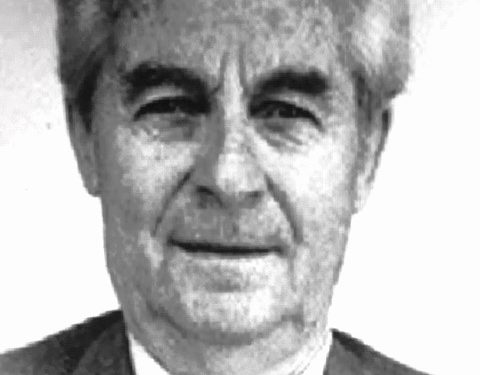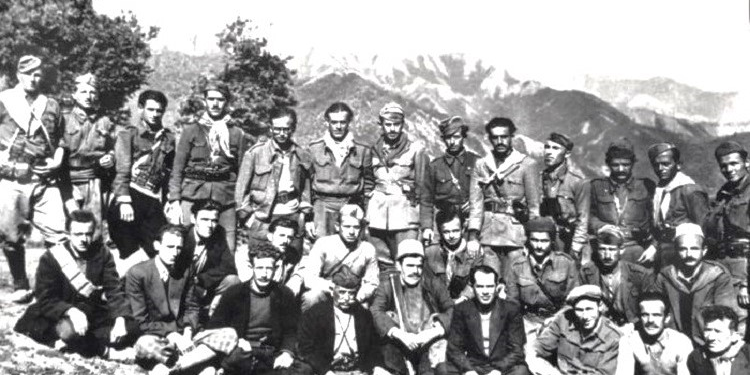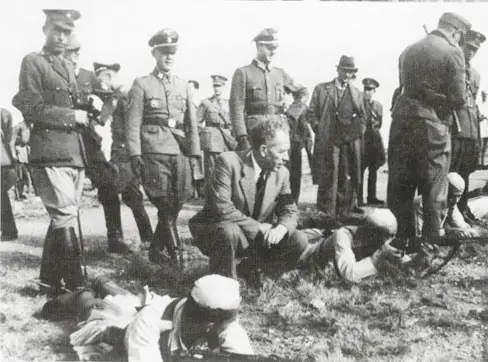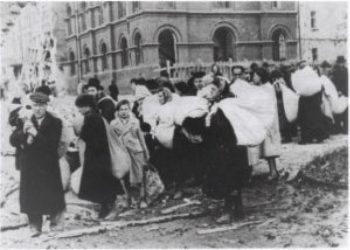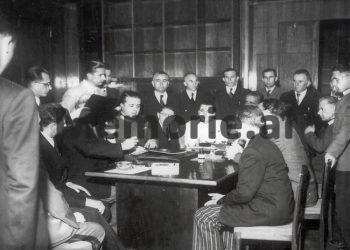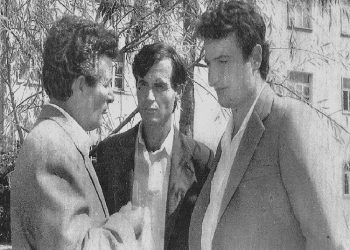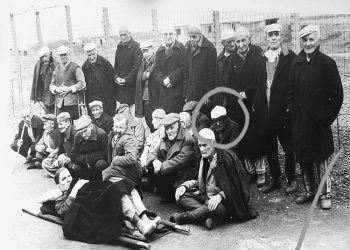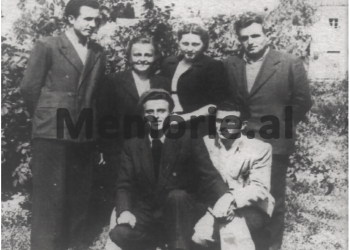By Myftar Tare
Memorie.al / In the burnt Borova, 107 residents were killed, with dozens injured, some of whom died later, or others who were crippled for life. In the village of Barmash, on July 6 and 7, 1943, German forces burned all the houses, killing 18 residents and injuring 7 others. German shootings at these villages continued day and night, without moving the forces from the country. On July 11, the Germans went with two companies to the village of Kagjinas. There they burned all the houses and killed 12 people, its inhabitants.
On July 6-7, 1943, the German occupation forces that came from Greece to Albania burned the villages of Borovë, Barmash, etc., killing and massacring dozens and dozens of their inhabitants. As one of the leading partisan cadres, who personally participated in those battles, I am giving my memories of those events, which cannot be easily forgotten from the historical memory of the Albanian people. The battles that the partisan forces of the Korça district conducted over the city of Leskovik, on May 15 and 16, 1943, made it possible for the fascist army units to withdraw from this city with losses, leaving it free.
I, the companion of the British officer, David Smajl
On May 15, 1943, the officer of the British mission, David Smajli, came to Leskovik from the area of Greece, who had previously entered the area of Zagoria, but the main leadership of the partisan headquarters of Gjirokastra had returned him to Greece. Due to the fact that I knew French, I was assigned to accompany the British officer, David Smajl, on a long journey to the Vithkuqi area of Korca. On the way he asked many questions, but his interest was to know how far the area of Elbasan was from where we were.
Based on the fact that I knew the city of Elbasan well, as I had stayed there for several years when I attended the “Normal” school, I immediately related his question to an English girl who had stayed for a long time in that city, where she had also built a villa, in which she stayed together with Lef Nosi. Based on the guidelines we had at that time not to give any information to the British missionaries, I lied to him, telling him that I had never been to Elbasan, and so I had no idea how far that city was, from where it was us.
The plan for the attack on the Italian forces
During the dates of June 15-20, 1943, the members of the Korça District Headquarters gathered in Vidhkuq: Nexhip Vinçani and Pëllumb Dishnica, as well as some members of the headquarters of the First Operative Zone, Vlorë-Gjirokastër, such as; Islam Radovicka and Tahir Kadare. They drew up the war plan coordinated with the districts; Korçë, Berat, Gjirokastër and Vlorë. The main blow that would be given to the Italian forces was predicted to be done in several specific points such as the city of Përmet, the camp site in the square of Kuqari, near the Vjosa River and in Këlcyre. In these three strategic points, many Italian soldiers were concentrated. The fighting against them began early in the morning of July 1, 1943, and continued until noon on July 3.
The war was quite fierce and the Italians put into action not only rifles, but also machine guns, mortars, and heavy artillery, as well as three planes that flew non-stop over the entire area where the fighting took place. It should be noted that the planes often created a lot of panic in some teams of the partisan forces, which retreated from the fighting line. Among them there were also some cadres, against whom, a few days later when the analyzes were carried out regarding the fighting we had done, a stand was taken and some punitive measures were also taken for the respective departments where the withdrawals without orders took place.
The burning of the city of Përmet by the Italian forces
On July 2, 1943, the Italian forces began to burn the city of Permet, whose fire continued the next day, July 3. During the fighting there were killed and wounded on both sides, but the Italians suffered more losses in men (killed and wounded), and war materials, as they were caught by surprise. Partisan forces had three killed and ten wounded. It must be said that on July 1, 1943, at the turn of the road to Mezhgoran, not far from Këlcyra, the commander of the company, our good friend, Asim Zeneli (“Hero of the People”) was killed.
After that, in the afternoon of July 3, the forces of the Korça District, which consisted of a force of 270 partisans, began to withdraw to their areas. I, together with six other partisan comrades, went to the area of Barmashi, to Ura e Shalesi, where we had left several other partisan forces, which had been concentrated there since June 25, in order to prevent forces from other Italians coming from their regiment of Erseka, to go to the aid of the forces that were installed in Përmet, and also endangered the city of Leskovik, which was free.
The four partisan ambushes for the Germans
Our forces had taken place in four ambushes: in the first ambush that was at the entrance of the village of Barmash (above Teqen Bektashiane), partisan units were deployed, with volunteer forces mobilized from the villages of the foothills of Gramoz and its plateau. These were under the command of Veli Pupa (Starja) and Raqi Kocace (Shtika).
In these positions, the number of members of the partisan units reached up to 93 people, and most of them had participated in the combat actions of 1942. At the head of this ambush, there were many places with trenches, which had been prepared since the years of the First World War (1914-1920), and reworked for the Italo-Greek war, in the years 1940-1941.
These trenches were quite favorable for our forces, which had to be protected from the blows of the enemy forces. In the second ambush, which was on the big rock near the Langarica River and on the road leading to the villages of Kamenik and Bënjas, the units of the area of Voskopoja and Vidhkuqi were placed, which were led by Nasi Vithkuqi. These forces consisted of 32 members of the units, but the place where they were concentrated had many difficulties, as it was quite rocky. The third ambush was in the hills of Sanjollas, where the highway had many turns, quite favorable for our forces.
Here was Riza Kodheli’s detachment with 42 partisans, which had been formed in the first days of February 1943. The fourth ambush was placed at Ura e Shalesi, where units from the villages were concentrated; Shalës, Arrëz, Gërmenj, Podë, Sanjollas. Gozhdarezhad, etc., which were commanded by Dervish Sanjollasi. These forces consisted of only 30 people, members of units that had participated in many battles. In the four ambushes there were a total of 167 effective, partisan and volunteer. In the morning of July 5, 1943, I and some other partisans arrived at the positions installed at the Shalesit-Barmash Bridge. As soon as I arrived there, I immediately gathered the main officials and informed them about the fighting we had carried out in the area; Through-Kuqar-Kelcyre – Kaf e Kiçokut-Mezhgoran and on the road Tepelenë-Vlorë.
I ordered my comrades to remain in these positions at all costs, as this was a definite order of the comrades of the Korca District Headquarters, and it would be implemented until a second order. At noon on July 5, 1943, I, together with my friends Janaq Borova and Sotir Qirjaqi, went to the village of Borovo and entered the house of the patriot Thoma Toto, (a friend of Fan Noli, who had fled back to the USA in 1925) , and there we asked for our courier, Sarandi Zguro. We would charge him with a mission to Korça, where he would deliver information prepared by comrades Nexhip Vinçani and Pëllumb Dishnica, to comrades Koço Theodhosi or Taqi Skëndi.He would leave from Erseka to Korça with his friends Koço Tane and the driver, Llambi Koçol Prodani, who was also the most loyal man, because of the secret connections I had with the main friends of the Korçë Circuit.
The announcement of the arrival of the Germans
On July 6, 1943, which was Tuesday, early in the morning, three enemy planes started flying over our heads, which continued their mission until 12 noon and then left in the direction of Korça. As it turned out later, the enemy planes had dictated the movements of our comrades, from one ambush to another, where they went to get food supplies. At 5:30 p.m. on July 6, Sarandi Zguro, a member of the “Youth Group”, who was a very resourceful and courageous boy, arrived. He worked as a waiter in the restaurant of Mërtiro Totoc from Borova, who also helped the Anti-Fascist Movement and the National Liberation War. Sarandi handed us a letter sent to me by Koço Tane Arëza, (a member of the Communist Party), who performed certain tasks on behalf of the main comrades of the Korçë District.
In that letter it was said: “At 12:30 on Tuesday, July 6, 1943, numerous German forces arrived in Ersek, with all kinds of weapons and stayed in the city. The end of them on the road coming from Korça is not visible. The soldiers did not get down from the vehicles. There are many armored vehicles, large tanks, cannons and heavy mortars. The Italian general did not give the German officers any guarantee for a smooth passage to the South. Similarly, the heads of the sub-prefecture and their collaborators, said what the Italian general said and added that; the Borovë-Leskovik area and up to Tri Urat, on the border with Greece, are under the influence and control of partisan forces”.
The first blow against the Germans at Teqja e Barmashi
At 5:20 p.m., the front of the German convoy arrived near the Bektashian Teqe of Barmashi, before the first ambush of our partisan forces. On the descent of the road, to enter the village of Barmash, a truck with soldiers crashed and it started to burn from the fire of the ambushing partisan forces. Immediately, the German forces started firing with all kinds of weapons at their disposal, opening fire from all sides. Many of the types of weapons that the Germans were using against us, we had never heard of before, such as the dum-dum, rifle bullets that exploded where they fell, or the lightning-quick “Saw” machine guns, mortars heavy, “Lanchia-Fiame” heavy caliber cannons, large and fast tanks and armored cars.
The German forces reached the slopes of the Barmash Bush and stopped there, after two mines that had been placed by the partisan forces exploded. From their explosion, two or three cars were damaged, which blocked the passage of other vehicles of the German convoy. At 18:30 in the evening, which was Tuesday, a lot of smoke was seen coming out of the village of Borovo, which the Germans had started to burn. In many of the houses that continued to burn, there were women, sick old people and small children inside who could not have left without the Germans arriving there. The punitive (terrorist) German party, which burned and massacred the village of Borovo, was prepared for terrorist actions of this nature and had done so in other places where they had passed.
This unit was commanded by Major Runbald Klebe, who was only 30 years old at the time. (He lived until recently and died in Germany at the age of 87. In these last years, his son came to Albania, who saw the places where his father was killed and burned. He was also in Greece where he photographed different countries, as well as in Albania). The commander of the German regiment that walked first was Colonel Jozef Salmanger (his place of concentration had been South Greece), while the commander of the mountain division was General Von Schlettner. This division had five regiments, each with 5,000 soldiers, i.e., a total of 25,000 selected soldiers, fierce in fighting and carrying out massacres. This division entered Albania via Kapshtica and came from Northern Greece, heading south, in order to subdue the disobedient Greeks.
The war of the partisan forces against the Germans continued without a break with the use of all types of weapons that the Germans had at their disposal. The partisan forces of the second ambush began to withdraw there from 21.00, as they had difficulty staying there due to the explosions of stones. At 9:30 p.m., the partisans of Riza Kodheli’s detachment also withdrew, as they could not resist the fire of the German artillery, which did not stop firing. The units of the villages of Ura e Shales, stayed until their people left their homes, in order to save their lives. The withdrawal of the forces of the first ambush units was done in order at 23 o’clock at night, withdrawing the five wounded that we had there. In the four ambushes from our side, we had 10 wounded and three others with slight scratches, from the explosion of stones from the German artillery.
The 26 killed Germans were laid out in the middle of the city of Erseka
In the evening of July 6, in the late hours of midnight, the headquarters of the German forces sent 20 killed soldiers (among them 2 officers), and laid their bodies in the middle of the city of Erseka. And on the morning of July 7th, he also sent there the dead bodies of 6 other soldiers, killed in the early hours of the morning, who placed them next to the other 20. This demonstration of the German forces in the middle of Erseka was done by their command, to later justify the massacres, murders, burnings, and looting done by them in Borovo, Barmash, and other villages. In the burnt Borova, 107 residents were killed, with dozens injured, some of whom died later, or others who were crippled for life. In the village of Barmash, on July 6 and 7, German forces burned all the houses, killing 18 residents and injuring 7 others.
German shootings at these villages continued day and night, without moving the forces from the country. On July 11, 1943, the Germans went with two companies to the village of Kagjinas. There they burned all the houses and killed 12 people, residents of that village, as well as 2 others who had gone there for friendship, from the village of Bënjas. From the village of Kagjinas, the German forces bombarded the village of Novoselë and the village of Zharkanj with artillery, damaging many houses. Their inhabitants, as soon as they had seen the burning of Kagjinas, had left the villages, saving their lives.
The villages; Sanjollas, Podë, Shale, Arëz, Gërmenj, Oseike and Vrepckë, were night and day, under the incessant artillery fire of the German forces. None of these villages remained without burning and damage to houses, as well as without injuries to their residents.
In Leskovik, the German forces entered on July 17, but did not find any of its inhabitants, as they had left in time for fear of retaliation. In that small town, the German forces burned all the houses that were left unburnt during the war that took place on May 15-16, 1943, with the Italian forces and then fled, leaving the town free. On July 17, the German forces went and occupied the Three Bridges on the border with Greece and from there, they launched their forces towards the villages; Charçovo, Seran, Vllahopsilloterë, Biovizhdë and Leshnica. In all these villages, they burned the houses and killed the people they found there. In Leshnica alone, they killed 5 people.
The population of the villages that the German burned, moved forever from their birthplace (mainly from Kolonja and Leskovik), and went and settled in Korça. The massacres committed by the German forces against the civilian population greatly outraged the people of those areas. But the creation of the First Partisan Brigade on August 15 in Vidhkuq and the fighting in Qafë e Qarri and Ura e Qukes, on September 9, created a belief in the ranks of the people, which was closely related to the Anti-Fascist National-Liberation War. In the village of Qarr, the Germans suffered heavy losses, including killed and wounded. Many prisoners and war material, various weapons and ammunition were also taken there.
Here the partisan forces also took the post office of the Germans, with postcards that they sent to their families. (Until recently I kept as a souvenir a postcard that a Habsburg family sent to their soldier son at the front). On July 20, German forces crossed the Three Bridges and entered Greece, where they were severely beaten by Greek partisans. The commander of the 1st regiment, Colonel Stainsigner, was also taken prisoner there, who was shot after the trial. The commander of the Greek partisans was Haris Vellojanis, (from 1945 he became a member of the Politburo of the Greek Communist Party), who was then killed after refusing to surrender to the Greek monarcho-fascist forces and their British allies./Memorie.al




